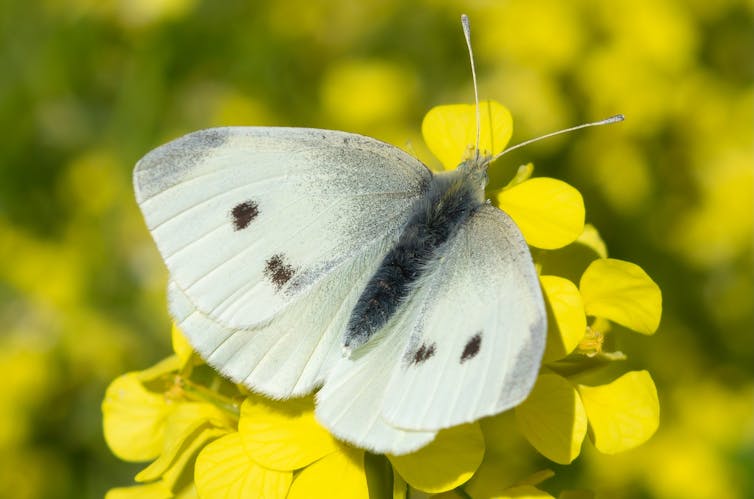Cabbage white butterflies – Pieris rapae – are one of the most common garden visitors across southern and eastern Australia. The butterfly looks elegant in white with black dots on its wings: females have a pair of black spots and males a single spot on each forewing. But their velvety green caterpillars are ravenous beasts on brassicas – the plant family that includes common vegetable crops such as cabbages, cauliflowers, broccoli, kale and bok choy.
Author
Nigel Andrew
Professor of Entomology, Southern Cross University
The species was accidentally introduced into Melbourne in 1929 from Europe. Since then, cabbage whites have spread all over Australia, finally reaching Perth in 1943.
Because of their caterpillars’ addiction to eating brassicas, it is one of the most pervasive pests of any crop worldwide. Recent conditions have been favourable, resulting in large numbers of cabbage whites.
One female can lay up to 800 eggs. When they hatch, the caterpillars prefer densely planted hosts in moist, warm habitats. The caterpillars’ biomass can double each day, making them one of the fastest-growing cabbage-feeding caterpillars.

Why are there so many this season?
Cabbage whites’ ability to exploit the moist and warm conditions over the past winter are one reason they are so pervasive at the moment.
They can also cope with cold. The pupae – the stage in which a caterpillar metamorphoses inside a cocoon into an adult butterfly – can survive temperatures as low as -20°C. Their cells can produce antifreeze proteins, which lower their freezing point if it does get cold.
Milder winters mean the overwintering pupae emerged and mated early. The female adults soon started to lay their eggs on planted brassicas.
The next generation of caterpillars can then start feeding without being predated on as their natural enemies take longer to emerge after milder weather. Cabbage white numbers then build up extraordinarily quickly.
What’s the appeal of brassicas?
The caterpillars are attracted and addicted to chemicals found in brassica leaves. These are the mustard oil glucosides (glucosinolates) – particularly sinigrin, which initiates caterpillar feeding.
Adult females are attracted to brassicas by another glucosinolate – glucobrassin – which prompts them to lay their eggs on the leaves. Females can “taste” these chemicals with hairs on their front legs.
The females also prefer greener plants – which they’ll find in well-watered and fertilised vegetable gardens – to lay their eggs.
How to live with them
A key way to control the caterpillars is to deny them access to your crops in the first place. Once the leaves start developing, cover the crop with insect-proof mesh. You can use garden hoops or bamboo as a supporting frame for the mesh.
When you remove the mesh to water or weed, do it in the early morning or late afternoon when the adults are not flying.
White butterfly decoys suspended on sticks generally don’t work to stop females laying their eggs. There is no evidence cabbage white females are territorial.
It can be useful to provide a “sacrificial” plant. Leave these out in the open to attract the adult female to lay her eggs.
As caterpillars increase in numbers, they will start to attract beneficial predators and insect parasitoids that lay their eggs on the caterpillars. Parasitoids are primarily wasps and can be very effective biocontrol agents. Their larvae feed on the bodily fluids or the internal organs of the host caterpillar, eventually killing it.
These beneficial insects need a nectar source to stay active. They will be attracted to gardens that are a bit “messy” with different habitats and flowers.
Remember, some green caterpillar-like animals are good guys. So, if you are fond of squishing the caterpillars, make sure they are the ones eating the foliage; not the voracious predators, especially aphids, eating the herbivores.
Just to make things more interesting, caterpillars, in general, that are feeding are about 100 times more likely to fall prey to predators and parasites than caterpillars that are hiding. Longer caterpillar feeding bouts usually happen on plants with lower nitrogen levels – so if you have a sacrificial plant, don’t fertilise it.
It can also help not to plant all your brassicas together. Mix up your vegetables and herbs. This provides your prized kale with companion plants and makes it harder for caterpillars to move from one plant to another.
Companion planting allows beneficial insects to find hiding places closer to the caterpillars, and also makes it harder for the female butterflies find your brassicas.
Avoid pesticides as much as possible
Don’t spray your garden plants with pesticides unless you desperately need to feed lots of family or are a serial entrant in the fruit and vegetable exhibition at your local show. The cost is huge relative to the benefit the chemicals bring you. In most cases you will be killing off many beneficial creatures in your garden.
If you must, the least harmful spray for humans and other natural enemies of the cabbage white is Dipel. This is an insecticidal product containing toxins derived from a bacterium, Bacillus thuringiensis kurstaki (Btk), which occurs naturally in soil and on plants. But it may be toxic to other butterflies and moths that pollinate your veggies, so be very careful where and when you spray.
Protecting your patch with mesh, rather than spraying, and providing space and food for natural enemies are great ways to keep the diversity up in your garden. Allowing a little bit of damage to your prized backyard crops enables some interesting biological interactions to occur in areas where it may have been missing for decades.
![]()
Nigel Andrew has received funding from the Australian Research Council, Grains Research Development Council, Meat and Livestock Australia, NSW Environmental Trust, and NSW Local Land Services. He is a Board member of the Ecological Society of Australia, the Australian Fulbright Alumni Association, and the NSW Entomological Society..








